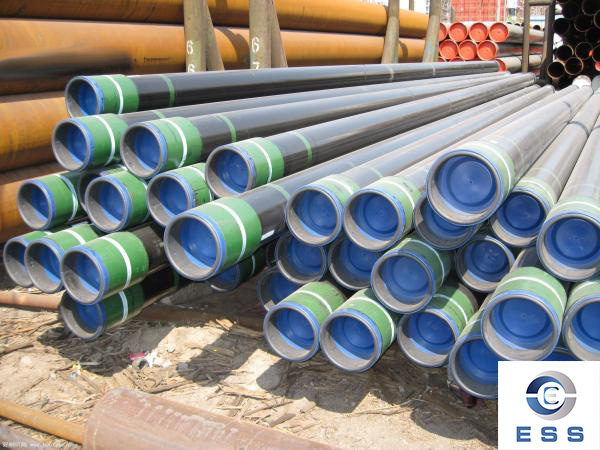Casing pipe drilling : How to run casing correctly

The basic concept of casing pipe drilling
Casing pipe drilling refers to lowering casing pipe in the wellbore to protect the wellbore wall and the stability of the wellbore wall. It is also one of the important links in the drilling operation. Casing pipe follow-up drilling is a key task to ensure the safety of the wellbore wall and achieve the target eccentricity of the wellbore wall. It must be operated strictly in accordance with the operating procedures to ensure the effect of lowering casing pipe and the safety of the operation.
How to run casing pipe correctly
1. Selection of casing pipe
Casing belongs to octg pipe, mostly made of seamless pipe.Before lowering the casing pipe, the wellbore characteristics and casing pipe specifications must be carefully analyzed and calculated, and the casing pipe of the corresponding specifications must be selected. The casing pipe must be equipped with a wellbore protector as needed, and the gap between the casing pipe and the wellbore protector must be filled with cuttings or mud.
2. Casing pipe placement
When placing the casing pipe, it must be ensured that the placement of the casing pipe and the distance from the wellbore wall meet the engineering requirements. The center position of the casing pipe must be aligned with the center of the wellbore, and the axis of the casing pipe must be parallel to the well axis. Before placing the casing pipe, the borehole diameter and the outer diameter of the casing pipe must be measured first, and the placement of the casing pipe must be determined based on the measurement results.
3. Casing pipe lowering process
When lowering the casing pipe, attention must be paid to the speed and direction of the casing pipe lowering, and the operation must be carried out in strict accordance with engineering regulations and safety requirements. The casing pipe lowering speed must not be too fast and should be controlled at no more than 10 meters per minute to avoid damaging the casing pipe or the well wall. The casing pipe lowering direction should ensure vertical lowering to avoid deviation or distortion to ensure that the casing pipe can be smoothly lowered to the predetermined position.
(1) Technical principle of casing pipe lowering
Casing pipe lowering is a technical process of lowering the casing pipe below the wellhead of the oil well and installing it on the wellbore wall of the formation. The purpose is to support the wellbore wall and prevent wellbore wall collapse and wellbore wall mud loss. In deepwater well operations, casing lowering is of great significance to ensuring wellhead safety, controlling drilling fluid pressure, and improving drilling efficiency. The principle of casing pipe lowering is to lower the casing pipe from the wellhead to the bottom of the well through a hydraulic chuck and a casing hanging tool.
(2) Casing pipe lowering technical operation process
The casing pipe lowering operation process mainly includes four steps: assembling lowering equipment, pre-lowering preparation, casing pipe lowering and monitoring, and cleaning after lowering.
Assembling lowering equipment: assembling hydraulic chuck and casing pipe hanging tool.
Pre-lowering preparation: measuring, checking well wall, and checking whether the equipment is normal.
Casing pipe lowering and monitoring: lowering the casing pipe from the wellhead to the bottom of the well through the hydraulic chuck and casing pipe hanging tool, and monitoring the operation process.
Cleaning after lowering: cleaning the lowering equipment, checking the operation effect and recording the operation status.
(3)Common problems and solutions for casing pipe lowering
Casing pipe stuck: adjust the chuck pressure, slow down the lowering speed, and use the casing pipe breaker to break the stuck part.
Casing pipe stuck at the bottom of the well: increase the chuck pressure, increase the lowering speed, and use the impactor to hit the casing pipe.
The pipe strings in the well are stuck: use the rotary joint chuck technology to rotate the casing pipe to loosen it.
(4) Importance of casing pipe lowering to deepwater well operations
The success or failure of casing pipe lowering directly affects the safety and efficiency of deepwater well exploration operations. After the casing pipe is lowered, the size and quality of the casing pipe and the wellbore must be strictly inspected to ensure the safety of the wellhead, control the drilling fluid pressure, improve the drilling efficiency, and lay the foundation for the smooth progress of deepwater well exploration operations.
Summary
Casing pipe drilling is an important task to ensure the safety of the wellbore and achieve the target eccentricity of the wellbore. It must be carefully planned and prepared before the operation, and the operation must be carried out strictly in accordance with the operating procedures. This article introduces the selection of casing pipe, the placement of casing pipe, and the casing pipe lowering process. The casing pipe lowering technology is cumbersome, but it is very critical. It is necessary to strictly monitor the operation process, find problems in time, and take corresponding solutions. At the same time, the rational use of casing pipe lowering technology can also improve operating efficiency, greatly shorten the well depth, and reduce the cost of well exploration. It has a very broad application prospect. I hope it will be helpful to those who work with casing pipe drilling.













 Eastern Steel Manufacturing Co.,Ltd not only improve product production and sales services, but also provide additional value-added services. As long as you need, we can complete your specific needs together.
Eastern Steel Manufacturing Co.,Ltd not only improve product production and sales services, but also provide additional value-added services. As long as you need, we can complete your specific needs together.










